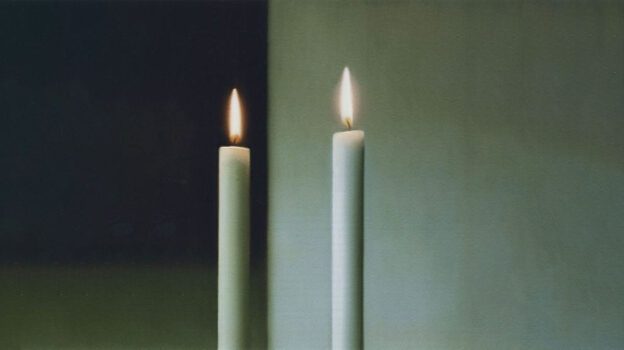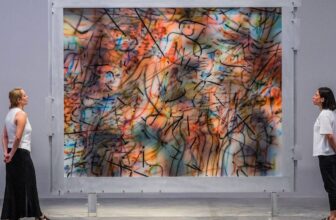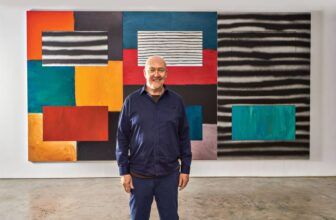What are Gerhard Richter’s Famous Paintings
On a gray morning in Cologne, a tall man with quiet eyes leans over a massive canvas, a steel squeegee in his hands. He drags the tool across layers of paint , thick, lush swaths of crimson, ultramarine, and gold , and in a single motion, weeks of careful work are transformed. Some strokes disappear entirely, buried under new pigment. Others peek through like memories refusing to fade.
That man is Gerhard Richter, one of the most influential and enigmatic artists of our time , a painter whose work defies neat categorization. He has been called a master of abstraction, a photorealist, a conceptual rebel, and the Picasso of the 21st century. His canvases have shattered auction records, hung in the world’s most prestigious museums, and inspired generations of artists. Yet, despite his fame, Richter remains intensely private, allowing the paintings to speak louder than the man behind them.
The Story of Gerhard Richter
Born on February 9, 1932, in Dresden, Germany, Richter’s early life was shaped by the turbulence of World War II. Growing up in the shadow of political upheaval and postwar recovery, he witnessed both the horrors of destruction and the resilience of rebuilding.
He studied at the Dresden Academy of Fine Arts in the 1950s, a period when East Germany’s cultural climate was dominated by Socialist Realism. Richter painted murals and official works for the state , but he was restless. When he saw his first Picasso in West Berlin in 1956, something shifted. The strict confines of East German art no longer felt like home.
In 1961, just months before the Berlin Wall went up, Richter escaped to West Germany. He enrolled at the Kunstakademie Düsseldorf, where he met artists like Sigmar Polke and Konrad Lueg. Together, they explored a style they called Capitalist Realism, a witty, subversive take on both American Pop Art and European painting traditions.
From there, Richter began a decades-long journey that would take him through photorealism, abstract painting, and conceptual experiments , all without ever settling on a single style.
What Was Gerhard Richter Known For?
Richter’s legacy rests on a paradox: he is famous for not being tied to any one visual style. He moves fluidly between photorealistic paintings that mimic black-and-white photographs, and enormous abstract works bursting with color and texture.
Some of the defining characteristics of his career:
Photorealism: In the 1960s and 1970s, Richter painted directly from photographs, creating blurred, almost hauntingly still images. These works explore the relationship between photography and painting, memory and perception.
Abstraction: His abstract paintings, particularly from the 1980s onward, are created using squeegees and palette knives, layering and scraping paint to reveal unexpected colors and shapes.
Political and Historical Themes: Some of his most powerful works , such as the October 18, 1977 cycle , address Germany’s postwar history, terrorism, and collective memory.
Experimentation: Richter has also created glass sculptures, mirror pieces, and overpainted photographs, challenging the boundaries of what “painting” can be.
He is, above all, known for his ability to make viewers question what they’re looking at and how they see.
Gerhard Richter’s Famous Paintings
Richter’s body of work is vast , more than 3,000 paintings and works on paper , but a few have become iconic:
Betty (1988)
A photorealistic portrait of Richter’s daughter turning away from the viewer. The detail is astonishing, yet the refusal of eye contact makes the painting feel intimate and elusive.Candle (Kerze) Series (1982–1983)
Simple, serene still lifes of candles against dark backgrounds, these works became symbols of both light and fragility.1024 Colours (1973)
A grid of bright squares inspired by paint sample charts, bridging Minimalism and Pop Art.October 18, 1977 (1988)
A 15-painting cycle depicting members of the Red Army Faction, exploring Germany’s confrontation with terrorism and its aftermath.Abstract Painting (Abstraktes Bild) Series
Vivid, layered abstract works, often created with a squeegee, that have become some of the most sought-after contemporary paintings in the art market.Cathedral Square, Milan (Domplatz, Mailand) (1968)
A large, photorealistic cityscape that sold for over $37 million at auction in 2013.
How Much Do Gerhard Richter Paintings Cost?
Richter is one of the most expensive living artists. His works have broken multiple auction records:
Abstraktes Bild (1986) sold for $46.3 million at Sotheby’s in 2015.
Domplatz, Mailand (1968) fetched $37.1 million in 2013.
Smaller paintings and works on paper can still sell for hundreds of thousands to millions, depending on size, subject, and provenance.
Prices for his works vary widely:
Small photorealistic works: $500,000 – $2 million
Large abstract canvases: $5 million – $40+ million
Glass and mirror works: $100,000 – $1 million
Richter’s high market value is driven by scarcity , he has slowed his output in recent years , and by the fact that his work appeals to both contemporary and traditional art collectors.
How Does Gerhard Richter Make His Paintings?
Richter’s methods differ depending on whether he’s working in photorealism or abstraction:
For photorealistic works:
He starts with a photograph, often personal or from newspapers. He projects it onto the canvas and sketches the composition. Using oil paint, he reproduces the image with remarkable precision. Then, he adds his signature blur, dragging a soft brush across the wet paint to obscure edges and create a sense of movement or memory.For abstract works:
He applies multiple layers of oil paint in bold colors, then uses a large squeegee or palette knife to drag paint across the surface. This process is unpredictable , colors mix and reveal what’s underneath. He often repeats this layering and scraping many times, creating depth and complexity.
The key to Richter’s process is controlled chance , he sets the stage for accidents to happen and then decides which ones to keep.
How Many Paintings Does Gerhard Richter Have?
Richter’s catalogue raisonné lists over 3,000 individual works from 1962 to the present. This includes paintings, drawings, overpainted photographs, and editions. His output has slowed in the 21st century, but he continues to experiment with new forms, including digital prints and glass installations.
What Art Style is Gerhard Richter Associated With?
This is where Richter defies easy classification. Over his career, he has been linked to:
Photorealism
Abstract Expressionism
Capitalist Realism (his own tongue-in-cheek term with Polke and Lueg)
Minimalism
Conceptual Art
Critics often say Richter’s “style” is stylelessness , the deliberate refusal to be pinned down.
What Materials Does Gerhard Richter Use?
Richter’s materials are deceptively simple, but his use of them is innovative:
Oil paints (for both photorealistic and abstract works)
Canvas and wood panels
Large squeegees (custom-made to his specifications)
Palette knives
Brushes (both traditional and soft for blurring)
Photographic source material
Glass panels and mirrors for sculptures and installations
Where Are Gerhard Richter’s Paintings Located?
Richter’s works are held in major museums, private collections, and public institutions worldwide. Notable locations include:
Museum of Modern Art (MoMA), New York
Tate Modern, London
Centre Pompidou, Paris
National Gallery, Berlin
Museum Ludwig, Cologne
San Francisco Museum of Modern Art
Metropolitan Museum of Art, New York
Art Institute of Chicago
Many of his most valuable works are in private hands, rarely seen except when auctioned.
The Enigma of Success
Despite his towering market presence, Richter often downplays the meaning of his own work. He has said:
“Art is the highest form of hope.”
Perhaps that is why his paintings , whether sharp as a photograph or wild as an abstract storm , continue to resonate. They are records of looking, of remembering, of being human in a complicated world.
From the quiet intimacy of Betty to the monumental sweep of his Abstraktes Bild canvases, Richter’s art refuses to settle, just as he himself has refused to settle into one style. In an age where branding is everything, Richter has chosen freedom.
Gerhard Richter Legacy
As of today, in his nineties, Gerhard Richter is still working in Cologne. His output is smaller, his movements slower, but his curiosity remains intact. Young painters study him for his technical mastery; collectors chase his works for their rarity and beauty; art historians debate his place among the greats of modern and contemporary art.
One thing is certain: when the story of 20th and 21st-century painting is told, Richter’s name will be there , not as a chapter, but as an entire volume.




